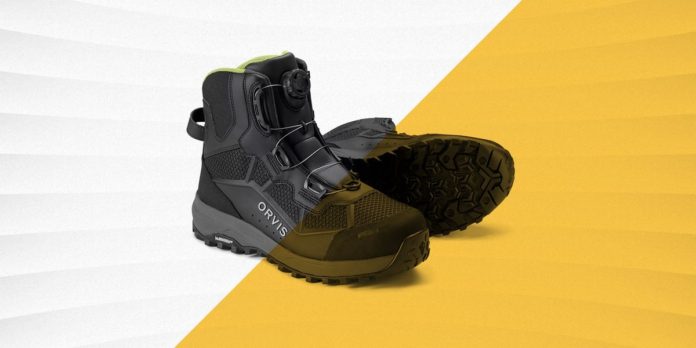Once, while walking in a small stream in regular hiking shoes, I slipped so fast and violently that I fell and fractured my finger. The soles of those shoes weren’t meant for traversing slimy rocks, and I learned the value of dedicated footwear meant for riparian environments.
If you’ve ever tried walking and standing while fishing in a rocky-bottomed river with currents pushing at your legs, you understand the need for wading boots designed for the task. Falls, especially those that result in injury, are a real threat to a river angler, and wading boots are a key piece of equipment designed to reduce that risk.
But, like most specialized gear, the highest-end products usually come with a hefty price—or with features you may or may not need. So before you spend top dollar, first determine which features are important for the type of angler you are. To help you make an informed decision, and possibly save you some money, we’ve outlined the wading-boot basics below along with seven products we recommend.
What to Consider
Type of Sole
The most basic feature to consider in fishing wading boots is the sole, and the most classic option is felt. Felt soles provide excellent traction on slippery, algae-covered rocks, but they also wear out quickly. If you often hike long distances between your vehicle and the river, from fishing spot to fishing spot, or in any amount of snow, felt is the least ideal choice. Felt has also fallen out of favor for its potential (however slim) to transport species between bodies of water. Some state agencies and bodies of water don’t allow felt soles for this reason, so check local regulations first. And even if you fish in places where felt soles are allowed, always clean and dry the soles before moving to another body of water.
Rubber soles are now far more common, and some outsole companies, such as Michelin and Vibram, make grippy soles specifically for better traction on wet rock surfaces. And unlike felt soles, rubber soles won’t wear out easily, making them the better choice for anglers who wear their wading boots on city streets or while traveling.
Cleats or studs can be added to soles, as well. Tyson Stark, avid fly fisherman and assistant store manager at Breckenridge Outfitters in Colorado, says the studs-and-felt combo is the tackiest option available. “If you have studded felt,” says Stark, “you’re least likely to have a fall.” But studs and cleats are not ideal for anyone who fishes from an inflatable kayak or paddleboard, as they can cause punctures.
Boot Height
Like hiking boots, wading boots come in varying heights, though most are a mid-height hiking boot style. A lower-height, lighter boot like the Orvis PRO Approach, which is essentially a sneaker, makes sense if you cover a lot of ground between fishing spots. A higher, more supportive boot like the 9-inch tall Korkers Darkhorse is best if you are concerned about instability in the water or have ankle issues. For most people, the mid-height boot is a happy medium.
Sizing and Fit
Like any shoe, proper fit is essential. When sizing wading boots, it’s generally best to aim larger than you would for hiking boots to make sure you have room for thick socks or neoprene booties. Stark says most men who come into his shop go a full size larger, while women tend to go only a half-size up. “Even if you buy online, go into a store and try boots on in person,” he says. “We get lots of folks coming in who saved a few bucks online but ended up with boots that don’t fit.” Stark also recommends taking your waders with you when trying on boots. Because different waders have different thicknesses, they can affect the sizing of your wading boots.
How We Selected
My selections are based on my years of experience fishing across the U.S., conversations with fishing guides, and advice from avid fly fisherman and assistant store manager at Breckenridge Outfitters, Tyson Stark, who sells a lot of wading boots to locals and anglers traveling to fish the several Gold Medal waters in the area. While I prefer float fishing, I have used Orvis wading boots and favor a rubber sole because I like moving around to different spots along the river. Because wading boots are a niche product for the fly-fishing market, our selections mostly include the familiar fly-fishing brands who make them. We’ve provided selections in a range of categories and prices to help you narrow your search quickly.
This content is created and maintained by a third party, and imported onto this page to help users provide their email addresses. You may be able to find more information about this and similar content at piano.io
Credit: Source link






























